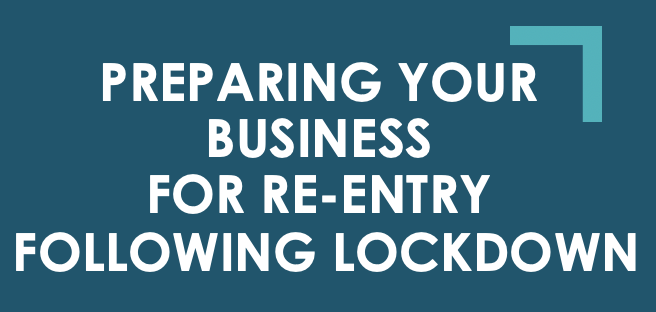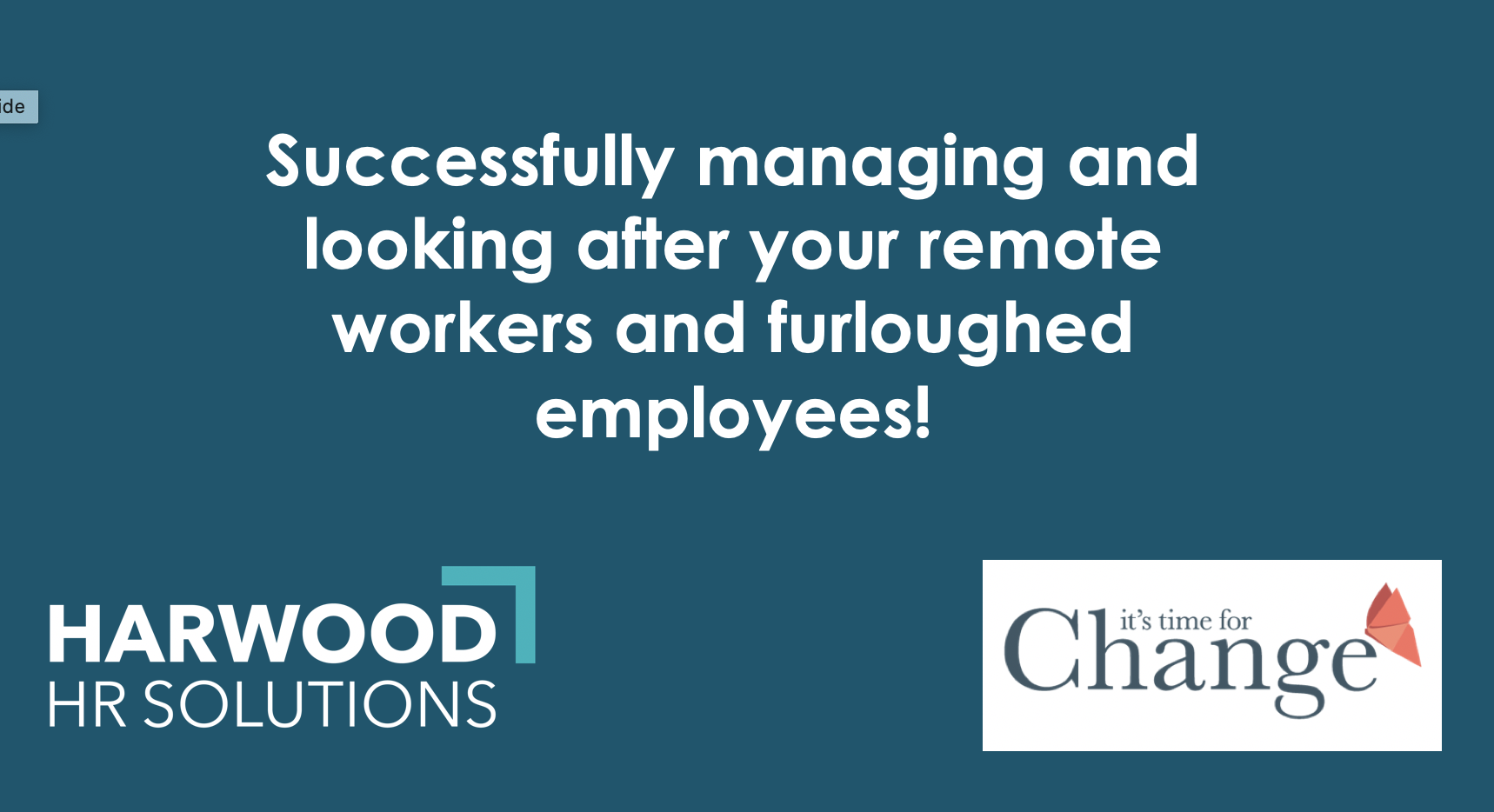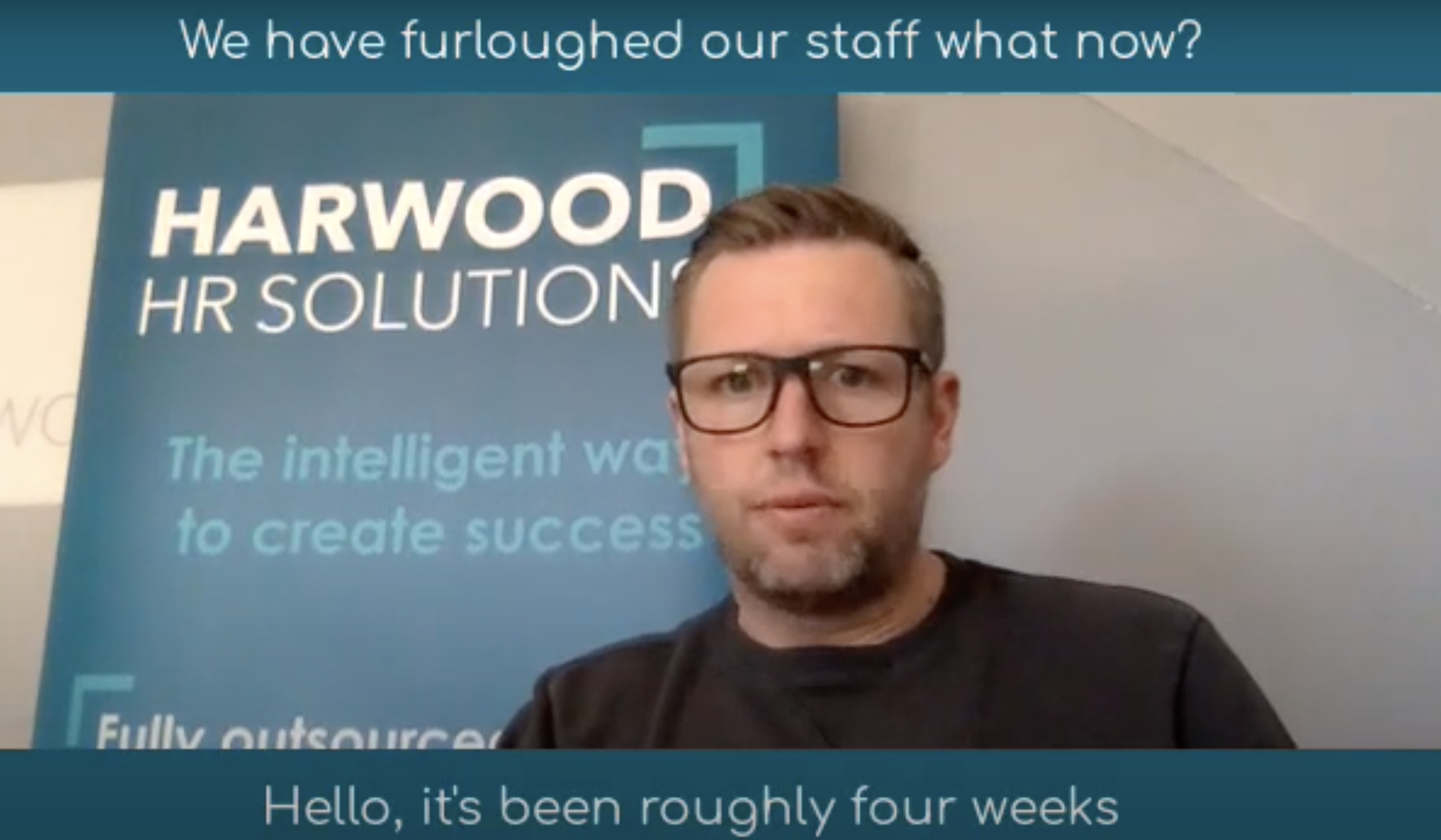Webinar – Preparing Your Business For Re-entry Following Lockdown.



Transcript:
So, preparing for re-entry. The latest news is that the government are planning a five-stage re-entry plan following lockdown.
It’s great news for businesses, great news for all of us as we can start to get back to normal, making money and getting our lives back to normal.
But as business owners this triggers a whole range of new things to take into consideration and a number of tasks to complete. So number one, how do I phase my business back in?
Is it everybody straight back in, we open the doors, customers come in, all the staff are back, its business as usual, the demands there, if that’s the way it’s going to happen then absolutely fantastic.
Wonderful news.
Step two, actually, it’s not going to happen quite like that. There’s going to be a phased approach back in we’re not expecting demand to come all the way back.
We need to phase out staffing. We need to reopen the business at different times. There are parts of the business that won’t reopen straight away etc….
Or number three, we need a completely new look business following this lockdown period. The coronavirus has destroyed our business as we knew it and we need to rethink about the way we do things immediately when we come back. So number one straight back in.
So the questions to ask around going straight back in and one is how do I return my staff from furlough? If I can return my stuff from furlough what happens if we have got employees that can’t return back from furlough because their health doesn’t allow them to or probably, which is going to be quite quite commonplace is people don’t feel comfortable about coming back in from furlough because they’re still nervous about the coronavirus etc.
Can I insist on them coming back?
What can I do to make that transition more comfortable?
What happens if they just refuse to come back?
Where does that leave me as an employer? Where do I stand?
What are my rights? So all those things that you need to consider in order to get straight back at it.
Number two, phased approach. Lots in the press at the moment about furlough about them pulling it back in it’s costing three times more than they expected.
It’s not sustainable. What we haven’t heard is that anything that’s going to pull it back from the current end of June deadline.
However, it’s pretty clear that the government want to wean companies off furlough and put the people off furlough as quickly as possible.
So as they relax these lockdown rules, there will be more pressure on businesses to get back at it.
And there will be more questions to ask of businesses who continue to furlough their staff.
So start planning for them to come back.
But what will happen after June? The government of hinted that there might be a gradual release of furlough.
We’ll have to wait and see.
So can I pull some people back off furlough and leave some people on? What happens if furlough just expires and I still can’t bring my people back?
What are my options? Can I lay people off? Do I make them redundant? Etc, etc. So lots of questions on a phased return back in.
The last piece here is a new look business. So I know I need to make redundancies, I need to close parts of my business, I need to close certain stores, I need to close a plant, whatever your business is you need to make significant change.
So if you need to make redundancies, you need to make contractual changes, pay changes, changes to bonuses, changes to commission, you need to restructure departments; you need to outsource functions; you need to close sites, offices, think about working from home.
All of these are massive tasks to undertake but are all doable.
Right! This is the opportunity to get your business into shape for the next 5, 10, 15 years following this coronavirus lockdown and potential recession.
So set your stall out for what you really need to happen. Plan it accordingly and all of this can be done.
However, I urge you to seek professional help guidance and support in doing it.
There’s lots of companies out there that entered into furlough on a bit of a hit and miss basis and you may or may not get away with that.
You know, you may get away with sticking people on furlough without issuing them the proper letters and consultation, but one thing’s for sure you will not get away with fudging the next stage.
You will not get away with fudging your entry. You will not get away with ignoring redundancy consultation process, etc. etc. etc. So, Get advice. There’s lots of HR companies out there and I of course will put Harwood HR Solutions forward as a very good choice if you need help and support, and if you need that help and support there’s a link on this video that will allow you to contact us and we’ll give you free consultation help guidance and support if you need it.
We will also follow this up with more videos. We will follow this up with webinars to help you through this process, but anything you need to ask just give us a shout and we’re on your side will help you out and above all else stay safe, above all else stay professional. Do it correctly.
Give yourself the right opportunity for being successful following this whole lockdown period. Thank you for the time to listen to the video.
I’ll speak to you soon. Thanks guys.


Transcript:
Hello, it’s been roughly four weeks since isolation here in the UK, lockdown!
Many of you as business owners will have taken an initial assessment of your business and the damage that potentially has been or will be done by this coronavirus outbreak.
You have made your assessment. You have got your head around furlough. You’ll have furloughed your staff and you probably or hopefully will have also managed to have completed your first claim for furlough funding.
So what next? Well, there’s a whole raft of things that as a business owner you should be thinking about and probably are thinking about. All of them of course, we can support you with here at Harwood HR Solutions, but managing the team while they’re off, staying in communication, managing well-being, managing mental health, all of those things can we can support you in addition to that starting to think about what sort of business you’re going to return with.
So do you need to make redundancies? Do you need to make structure change? Do you need to change the way that you work? Do you want to do you need to consider more the options of home-working now that you’ve tried it in this period? etc, etc. So again whole new world of stuff that again we can we can more than support you with.
In the interim period though and whilst people are still on furlough, there may be situations where you want people to come off furlough and do some work.
The question is can I do that and then send them back on furlough the answer to that is yes,
they need to have been on furlough for three weeks consecutive weeks in order for you to claim.
But ultimately if the works there you can bring them back and then put place them back on furlough.
And also you may ask that when we send people on furlough the original furlough deadline was the end of May now the government’s extended it to the end of June, can we extend furlough the answer to that is also yes, so these are things that can be done relatively easily here at Harwood HR
we have produced some template documents for you to use that will keep you on the right side of all things legislation and the tick box for HMRC when they come and audit you.
So if you want use of those documents, please feel free to click the link below
and then we’ll send them to you if you need any more support at all.
Just let us know. Take care. Stay safe.
Speak to you soon guys. Bye.

April is usually a time when we are busy talking about all of the new updates to employment law and making changes, however with the current COVID-19 crisis being hot topic, this has of course, not been as high on people’s agendas. We have all been busy trying to understand furlough, how to claim on the job retention scheme, how to deal with sick pay, self-isolating and shielding employees etc, but we cannot ignore these changes to employment law and must ensure that organisations comply with the new pieces of legislation.
As well as the usual increases to statutory payments, there are a number of other points you need to know to keep you in line with the law. In addition to the below, the government has confirmed the that extension of IR35 tax rules to private sector employers will be delayed until 6th April 2021.
Changes to Written Statements of Terms and Conditions
From the 6th April 2020 it is a requirement to issue a written statement of terms and conditions on day 1 (the right to a statement no longer requires a minimum length of service and applies from the worker’s first day working for the organisation). This is for both employees and workers, including casual and zero-hour workers.
There are a number of changes to the contents itself also and so it is a good idea to have your template reviewed.
For those of you who currently send out their written statements with their offers of employment, prior to the proposed start date, this will not make a lot of difference provided their statements comply with the new requirements.
New right to Parental Bereavement Leave and Pay
The Parental Bereavement (Leave and Pay) Act 2018 (also known as Jack’s Law) provides at least two weeks’ leave for employees following the loss of a child under 18 on or after 6th April 2020, including parents who suffer a stillbirth after 24 weeks of pregnancy.
All employees regardless of length of service are entitled to parental bereavement leave and those with 26 weeks continuous employment and who meet earnings requirements will be entitled to statutory parental bereavement leave pay.
Third Gender Pay Gap Reporting Deadline
Most businesses with 250 or more employees would have already been in the process of finalising their gender pay gap reports, their third one since the reporting requirements came into force in April 2017. However, due to the coronavirus outbreak, the government announced it would suspend the reporting requirements this year.
Given that the dates for reporting were 30th March for the public sector and 4th April for the private and voluntary sector, most employers would have the data ready and so encouraged to report this once the outbreak has passed.
Statutory Payment Increases
Ensure that updates are made to calculations of statutory pay. New rates as below:
| Weekly payments | April 2020 |
| Maternity/Paternity/Adoption/Shared parental pay (from 5th April) | £151.20 |
| Sick Pay (from 6th April) | £95.85 |
| Redundancy Maximum Weekly Pay Cap (from 6th April) | £538 |
| Hourly payments (from 1st April) | |
| National Living Wage Workers aged 25 and over | £8.72 |
| Workers aged 21-24 | £8.20 |
| Workers aged 18-20 | £6.45 |
| Workers ages 16-17 | £4.55 |
| Apprentice rate* | £4.15 |
| *Apprentices are entitled to apprentice rate if they are either aged under 19 or over 19 and in the first year of their apprentice. Otherwise NMW applies |
Adjust holiday pay calculations for workers with irregular hours
From 6 April 2020, the holiday pay reference period for workers without normal working hours increases from 12 weeks to 52 weeks.
You will therefore need to adjust how you calculate holiday pay for those working irregular hours and possibly amend any leave policy that refers to the holiday pay reference period.
Ensure qualifying agency workers receive equal pay
On 6 April 2020, the ability for employers to pay agency workers less than their own workers in certain circumstances, also known as the “Swedish derogation”, is abolished.
Under the derogation, agency workers can exchange their right to be paid the same as directly recruited employees for a contract guaranteeing pay between assignments.
Following the abolition of the derogation, you must ensure that agency workers who have completed the 12-week qualifying period are paid equally to other staff.
As always, lot to consider, but we are here to support you. If you need help with this or anything else in the HR world, please contact us.
0203 936 9171

Following our webinar “A Simple Guide to Furloughed Workers and The Coronavirus Job Retention Scheme” we had lots of questions through and so have recorded these and our responses to share with you all.
I hope that you find them helpful!
If you need any support with this, redundancies or how to manage employees who are remote working / furloughed, please get in touch.
“If I Furlough employees and cannot take them back when the scheme finishes, as I need to build up my business again, what should I do? I have read I may have to pay the 80% back to the government if I make them redundant -is this correct, what should I do?”
No this is not true. An employer would not be required to repay the grant it has received for the employee’s wage while they were furloughed.
HMRC guidance on the scheme states that, when the scheme ends, employers will have to decide whether employees can return to work, or if redundancies may be necessary.
The employer would have to comply with the normal procedural requirements in relation to notice and consultation before making employees redundant.
While it confirms the position regarding redundancies when the Coronavirus Job Retention Scheme closes, the HMRC guidance does not state that a furloughed employee cannot be made redundant while the scheme is still open. Therefore, it appears that an employer could terminate an employee’s contract for redundancy while they are furloughed, provided that it complies with the relevant procedural requirements. The position may be clarified in further government guidance on the scheme.
“How does the furlough process work for those of us who are employed by our own companies as Directors where we take a modest “wage” and directors fees and pay full PAYE. There seems to be a perspective that we are “self-employed”
If you are a director paid through PAYE you can be furloughed in the same way an employee can and claim through the scheme for the salary elements that are paid through PAYE. Directors can still perform statutory duties, for example, accounts, payroll etc; but cannot perform any revenue generating work. Self-employed individuals are not paid through PAYE, do not pay tax in the same way an employee does and complete a self-assessment return at the end of the year. So, if you are a director of a limited company with limited liability, you would follow the furlough process as opposed to the Self-employed income support scheme. In any case, the HMRC will make an assessment based on previous tax return and company status and ask you to apply online for this scheme if applicable to you.
“Our employees are on zero hours contract (we are a hotel), it’s going to be difficult to furlough employees as we think it will take up to twelve months to be back to where we were. Also, one employee only started mid-February, will he be eligible having worked five weeks”
Given that it is really difficult to predict the future at this stage, the best option really is to furlough employees if they are not working and then review this again at the end of the 3 months. As we have discussed today, the purpose of the coronavirus job retention scheme is to prevent redundancies and so it may be a little too soon to act now. Given that they are on zero-hour contracts, it is a good idea to understand if they are workers or employees. If they are workers, you can simply look to give notice to end the contract, however, if they are employees, there is a process to following including providing notice.
In regards to the employee who started mid Feb – if he was on payroll on or before 19th March, he can be placed on furlough.
“We are a contract flooring company and our labour on site is a mix of PAYE and subcontractors. We are furloughing our employees on PAYE. Are we still at liberty to continue to use sub-contractor labour on the sites that currently remain open, while our own PAYE employees are furloughed?”
I think here you need to consider what you would do in a normal redundancy situation. Ordinarily, the first thing a business should do in this instance, would be to look at releasing contractors first; except in the case of course, where there is a particular expertise that is required from them. You should then work through to assess what other roles could be removed. There could be the argument that if you can’t afford to keep the employees working, how can you afford to pay the contractors? So, in short, no there is no liability to keep them. Familiarise yourself with their contract, however, if they are true contractors, you should be releasing them before employees.
Can an employer rotate which employees are furloughed during the coronavirus crisis?
Guidance published by HMRC states that the minimum period an employee can be furloughed for is three weeks. Therefore, it appears that an employer can rotate employees between periods of work and periods of furlough, as long as they are furloughed for at least three weeks at a time. An employer may choose to do this to avoid disputes over which staff are chosen to be furloughed, where it needs some staff to continue working during the crisis.
Can an employer withdraw notice of redundancy that was given before the announcement of the Coronavirus Job Retention Scheme?
Some employers facing immediate financial difficulty because of the coronavirus crisis will have given notice of redundancy to employees before the scheme was announced. HMRC guidance states that these employers can ask the employees to agree to the withdrawal of the notice, and to agree to a period of furlough instead.
Once notice of redundancy has been issued to an employee, it is legally binding and cannot be unilaterally withdrawn by the employer, even if the employee is still working out their notice period. Therefore, the employer must obtain the express consent of the employee. In the circumstances, it is likely that employees will agree to keeping their jobs, while staying at home on reduced pay, as an alternative to redundancy. The employer can agree to top up the wages of the employee, so they are paid in full, but it is not obliged to do so.
Can employers bring back employees who were made redundant before the Coronavirus Job Retention Scheme was announced, and make a claim for them under the scheme?
HMRC guidance on the scheme states that employees that were employed as of 28 February 2020 and on payroll (i.e. notified to HMRC on an RTI submission on or before 28 February) and were made redundant or stopped working for you after that, and prior to 19 March 2020, can also qualify for the scheme if you re-employ them and put them on furlough.
The employer cannot make a claim under the scheme in relation to employees who were not on the payroll on 28 February 2020. Employees who had already been made redundant by that date are not covered.
We run community transport and have workers over 70 who have had to self-solate. Are they on SSP for 12 weeks or can we furlough them?
Can you top up 80% for furloughed workers to full pay?
Employees who are at very high risk of severe illness from coronavirus and are therefore advised to shield themselves for at least 12 weeks, can be furloughed. Those aged 70 and over are classed as high risk or ‘vulnerable people’ according to the government. IF they are unable to work from home and their role would be furloughed if they were not self-isolating, then you can furlough them. If their role is required and they have not received a letter from the NHS categorising them as high risk, but are self-isolating it would be unpaid.
Employees who are on sick leave or who are self-isolating can be furloughed only after the period of sickness or self-isolation has ended. During this time, they will be entitled to statutory sick pay.
Yes, you employers can top up to full pay if they wish, but are not obliged to do so.
We have an employee who started on the 24th Feb. We pay our staff 2 weeks in hand therefore the new employee was not on our Feb payroll. Do you know if we could claim Furlough for this person?
The scheme now states that you can claim for employees that were employed as of 19 March 2020 and were on your PAYE payroll on or before that date; this means that you will have made an RTI submission notifying HMRC of payment of that employee on or before 19 March 2020 and so will depend if they meet this requirement?
If they are not eligible and you have no work for this person, there is still the option to consider lay-off, but this would under the usual lay-off terms, i.e. no pay other than the statutory guarantee payments.
Hi, we are a 2 director company (me and my partner). We have a number of contracts paused so can 1 of the directors be furloughed? We have been trading for a year but I have only been paying myself for the past 3 months. Do you know how the amount you can claim will be calculated?
Yes, you do not have to furlough all employees where some are required to continue working and so this will be the same for Directors. You can claim for the salary element that has been paid to you through PAYE and so 80% of your normal wages up to £2,500. The grant is for 80% of the employee’s gross pay. The guidance states that “the employee’s wage will be subject to usual income tax and other deductions”.
Member of staff is on maternity. Requested return early inc reduced hour’s notice received but not accepted yet as we closed. can I delay the return or can I furlough on return?
Ensure that the member of staff isn’t returning too early under health and safety law (2 weeks Maternity Leave (4 weeks if you work in a factory or workshop) immediately following the birth of your baby).
If that is covered then you need to consider her return request (including reduced hours) following the flexible working process. If you can accommodate her flexible working request then you can agree to it however, you must inform her that she is required to be placed on furlough. You will reduce her hours and pay accordingly and claim back 80% of that.
You will need to write to her to confirm that you have agreed to her flexible working request (with a timescale to be reviewed if this is not a perm change) and also provide her with a Furlough Agreement to sign.
If our business has not been affected by coronavirus as a whole but specific departments have been, can we furlough the staff who fall in to the departments that have been? Can you just confirm that you said shielded employees should be sent home on full pay if the business is trading normally?
If whole departments have no work as a result of the current COVID-19 crisis, then you can furlough them.
Correct, if you have employees who need to shield they should be at home on full pay. If their role would be furloughed should they not already be shielding, then you can furlough.
I’m on Furlough leave, will my employer allowed to ask me to work during this time or not?
No work can be carried out while placed on furlough. Should the employer wish you to come back to work then can end furlough and bring you back in. The minimum period you can furlough for is 3 weeks.
Roll over hol. is that public or private sector?
Both for private and public sector. The government has made an adjustment to the working time directive to allow employees who have not been able to take leave due to COVID-19 to carry this over. For more info:
Hi, can you clarify the holiday situation during the furlough period? I understood that you could reduce the holiday ‘entitlement’ pro-rata for the time an employee is furloughed i.e. if an employee has a 28-day holiday entitlement, if furloughed for 12 weeks, their remaining holiday entitlement, assuming no days taken before the furlough period, would be reduced by 6.5 days
Employees will continue to accrue statutory annual leave while furloughed. Entitlement cannot be reduced.
With offices closed how do you recommend the consultation process?
In these circumstances, you can arrange to hold consultation via phone, whether it be group or individual calls. Where possible try to ensure that staff get the same info at the same time if it is affecting a number of people and so would suggest a conference call / skype / zoom session. Keep notes and a log for your records.
Is the £2,500 per employee net pay or gross pay? i.e. before or after deductions for income tax / NI
The grant is for 80% of the employee’s gross pay (up to £2,500). The guidance states that “the employee’s wage will be subject to usual income tax and other deductions”.
Thanks, we are thinking we’d like to enforce annual leave to both FT and zero hours employees for those that have furloughed, up to 80% of accrued entitlement to ensure that it is recoverable under the scheme…any thoughts?
Unfortunately, holiday pay is not recoverable. If you wished to request employees take annual leave, you would need to bring them off furlough for this period of time, pay full pay and then place back on furlough. If you wanted to do this, you must tell staff at least twice as many days before as the amount of days you want people to take. For example, if you want them to use 5 days, you should tell them at least 10 days before.
Can they then go back on furlough a second time?
Yes, they can be furloughed effectively more than once. As above, Guidance published by HMRC states that the minimum period an employee can be furloughed for is three weeks. Therefore, it appears that an employer can rotate employees between periods of work and periods of furlough, as long as they are furloughed for at least three weeks at a time. An employer may choose to do this to avoid disputes over which staff are chosen to be furloughed, where it needs some staff to continue working during the crisis.
Are apprentices eligible?
Yes, so long as they are paid through PAYE and were on payroll on 28th February.
What if someone has not been employed for 12 months on irregular hours?
Assuming this question is in relation to calculations of monthly wages;
If the employee has not worked for 12 months before the claim, the calculation should be based on their average monthly earnings since they started work.
If the employee started in February 2020, the guidance says the employer should “use a pro-rata for their earnings so far”, to calculate what they would earn in a month.
An employee handed in their resignation before all of this. Leave date 20/07/20 (we’re a term time only preschool) What do we do here? We are not expecting to go back with children before September so cannot “retain” her? She has also got a job at a local supermarket while we are shut.
You are under no obligation to rescind his / her resignation (despite what Martin Lewis said). If they are currently working their notice and would normally be earning at this time then you will need to furlough them. If the governments job retention scheme ends and you are still closed then you may need to consider extending into statutory lay-off which is likely to be unpaid. (Clearly you will need to fully understand their contract beforehand)
With regard to HMRC portal and the question re the claim period end date – is that open ended given the government isn’t able to define lockdown will end.
At present the only confirmation is that “The Coronavirus Job Retention Scheme is a temporary scheme open to all UK employers for at least three months starting from 1 March 2020”

It’s World Health Day and Stress Awareness Month. That certainly calls for a minute to take stock on where we’re at and where we’re going. Many of us are keeping up to date with news of Covid-19 in the UK and around the world, but are we really checking in with ourselves? If we don’t look after number 1, why would anyone else? If we don’t look after our teams, who else will?
The word ‘Coronavirus’ is shaping up to be the biggest story in Google trends history (click here for graph and twitter discussion) as we struggle to keep our companies afloat, plan long term survival, deal with redundancies and furloughing, and the overwhelm or boredom that can result. Interestingly, boredom triggers stress too – our brains need to be engaged in meaningful activities that give us a sense of purpose. Being stretched is different to stress and I personally never to refer to stress as a healthy state. It’s when we are stretched too thin that we break. The smallest things can cause the step from stretch to stress.
In addition to work worries, our anxiety about family, friends and health has increased. For me personally last week it was having to find time in an already busy week to queue for shopping (with the likelihood of getting online grocery slots a bit like winning the lottery), having to clean the house (our beloved cleaner disappointingly isn’t considered essential) and home-schooling (thank goodness it’s now the Easter ‘holiday’). My husband and I are constantly checking in with how we’re attempting to get all this to work, which changes day to day depending on how we feel and what else is going on outside our control.
Taking Ownership for your own Stress
It’s very easy to feel like a victim when we’re stressed, and to blame others. I’ve written in previous blogs about the power of mindset, alternative perspectives, of positive psychology and of increasing our resilience to reduce stress. But sometimes, we need to take action.
Mike, who I wrote about in February (The Bus is Coming but When – blog) decided to take responsibility of his feelings and speak up. He asked for a meeting with his manager to say that he didn’t feel things were going as well as he hoped and that he wanted to get on better. That’s a great starting point. Mike was able to say what he wanted (focusing on positive outcomes rather than criticism) and discuss what might help, from both of them, to achieve a desired future. As a result, Mike’s stress has dropped. And I’ve no doubt his managers’ has too, both individuals now sharing the same path.
What can you do to reduce your stress? It might be about psychological approaches I’ve shared previously or taking action.
Spotting Stress Remotely
When we’re in physical contact with people it can be easier to detect stress. Seeing a change in someone’s energy, communication and mood all signal that something might not be right. But over video, or worse, the phone, this can be more tricky. We don’t see the signs as easily. When people are in ‘video mode’ for an hour, it is easier to put on a mask. We really need to be aware that what we see is just face-value
Cue yourself to look out for signs of stress in others so that you’re more likely to recognise them. Remember that only 7% of communication is via the words we use so you have a lot of other signals to pick up on. These might include:
One of the most powerful strategies to support others at this time is to focus on positive relationships. We’re most likely to share what’s really going on for us when we have genuine emotional connections with people that are based on complete acceptance and without judgement. How many of us really experience that? How many of us have that with work colleagues, friends and family? It starts with YOU.
Take Action!
Look out for the signs
Check in daily with people showing some of the symptoms of stress
Use video instead of the phone
Focus on identifying what can change; be solution-focused
To discuss further, check out concerns or explore potential ways forward, please contact me. I’m happy to help. We’re in this together.
Lisa LLoyd


Working from home? Sounds fine. But then add into the mix occupying your children and taking on the role of teacher. And the fact that tempers may be getting frayed as we spend so much time in each other’s company. Could be a recipe for significant stress unless you follow some simple steps.
Remember, we’re only human and we have off days! That tension is magnified when everyone happens to be having an off-day together and in my opinion, it’s better just to shelve the work plans and do something to improve everyone’s mood and strengthen your emotional connection. Maintaining positive relationships has got to be the priority right now.
For more advice on staying emotionally well working from home, see my blog.
TALK! I’m happy to help. If, like most, you’re grappling with how to keep yourself and your team well in these uncertain times, get in touch. I’m here to listen and share my expertise in being psychologically well. This is not a time to be ‘heroic’ and go it alone.

Background
The Government has introduced a Job Retention Scheme for Furloughed workers. The term Furloughed refers to being sent home with no pay due to having no work. The term isn’t common in UK law as we have legislation around “lay-off”. In the UK “lay-off” means to send employees home / reduce their hours due to having a reduction in demand with or without pay dependent on contract. If it is without pay then then they can receive statutory lay-off pay of £29 per day for 5 days in any 3 month period (bugger all!) If the individual is on lay off for 4 consecutive weeks or a total 4 weeks in 6 then they can request to be made redundant.
The Governments Job Retention Scheme is designed to reduce redundancies; therefore, it only pays out for those that are sent home and are not working. Hence why they have used the term Furloughed and not “lay-off”. They have however, insisted that to implement this you must follow existing legislation around “lay-off”.
What is that Legislation and what are they offering?
Firstly, an individual is only eligible for a payment if they have had one month’s continuous service (paid through PAYE) prior to the lay-off. They must also be sent home and must not be conducting work from home.
To implement the lay-off you must have a lay-off clause in your employment contract (rare – more common in manufacturing organisations). If you have the clause you can simply enforce it as per your policy.
If you don’t have a contract clause then you must consult with your employees in order to gain their agreement. You must ensure that they individually sign a lay off agreement also. In normal circumstances the consultation period needs to follow a process and if more than 20 employees are impacted you would need to collectively consult, however given the current circumstances we believe that it is only practical to short cut this process. Ultimately your justification is valid, they will receive at least 80% of their salary for staying safe at home and they will not ultimately be made redundant which is the alternative option.
How do we get the money and how much?
HMRC are currently working on this and your Accountant / Payroll provider will update you as soon as they have the data. It is likely that there will be some form of refund process through the HMRC website. They have promised that this is imminent.
They have currently offered to pay for 80% of a furloughed employee’s salary (capped at £2500 per month includes NI and Pension). You do not need to make up the 20% but you can choose to do so if you can afford it.
Employees with less than a month’s service will not receive any government support therefore you can either pay for this yourself or you can terminate their contract (following a process).
Other points
Please be aware that employees on lay-off still accrue statutory holiday (FT 28 days inclusive of bank holidays). You can insist that they take pre-booked holidays. You will pay full pay for their holidays and then back on lay-off after. Alternatively, if you can’t afford that then they can accrue holiday and take later in the year.
Bank holidays are as normal. If they normally work them then they will be on lay-off. If they don’t or you are shut then you can opt to pay for the bank holiday day and the day reduces their overall accrued entitlement.
Should you need them to complete work duties from home or return to work you can do this. They will come off their lay-off and return on their normal salary.
Note
We expect that there to be stringent anti-fraud measures and we warn all business owners that in the event of abuse of the system, they should expect public naming and shaming for what will be, after all, a form of illegal profiteering from a national crisis. We expect heavy penalties to follow for those who abuse this benefit.
Please contact us if you need any further help with agreements, support and advice.

The Labour Employment Rights Green Paper The Labour Employment Rights Green Paper represents a significant shift in the UK's approach to employment law, aimed at enhancing worker rights and adapting...
Read more